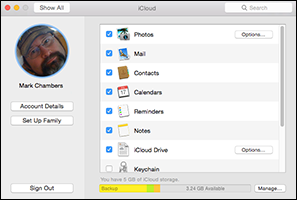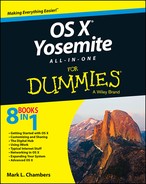Chapter 4
Expanding Your Horizons with iCloud
In This Chapter
![]() Introducing iCloud
Introducing iCloud
![]() Merging iOS and Yosemite using Handoff
Merging iOS and Yosemite using Handoff
![]() Setting iCloud preferences
Setting iCloud preferences
![]() Managing iCloud storage
Managing iCloud storage
If you ask the average Mac owner about what’s available on the Internet, you likely hear benefits such as email, online games, web surfing, and Google searches. What you may not hear is “instant syncing, cloud storage, and document sharing among all my Macs and iOS devices.”
If you have another brand of phone or tablet, you may have experienced what I like to call the “Synchronizing Blues” in the past: When you took a photo with your phone or created a new document with your tablet, your new additions just sat there (in their original location) until you had a chance to sync your device with your computer. Ah, but with Apple’s iCloud functionality, your stuff on your Macs and iOS devices gets automatically synchronized across the Internet!
In this chapter, I show you what’s really exciting about your Mac and that fancy Internet connection. With iCloud, you can automatically synchronize your stuff, access your documents with any Internet connection, and manage online backups of all your contacts, calendars, mail, bookmarks, and documents!
So How Does iCloud Work, Anyway?
Today’s iOS devices can all display or play the same media: photos, music, books, TV shows, and such. Heck, iOS devices (your iPhone, iPad, and iPod touch) can even share applications. Therefore, it makes sense to effortlessly share all your digital media across these devices, and that’s what iCloud is all about. Apple calls this synchronization “pushing.”
Here’s how the pushing process works. Imagine that you just completed a Pages document on your iMac (an invitation for your son’s birthday party), but you’re at the office, and you need to get the document to your family so they can edit and print it using your son’s iPad.
Before iCloud, you had to attach the document to an email message or upload it to some type of online storage such as Dropbox or Microsoft’s OneDrive, and then a family member had to download and save the document to the iPad before working with it. With iCloud, you simply save the document on your iMac to the Pages folder on your iCloud Drive, and OS X automatically pushes the document to the iPad (using the same Apple ID). Your document appears on the iPad, ready to be opened, edited, and printed — and it appears on any other devices running iOS 5 or later (using the same Apple ID) as well. Figure 4-1 gives you an idea of what’s happening in the background when one of your devices pushes data using iCloud.

Figure 4-1: iCloud works by pushing data among all your iOS devices.
iCloud isn’t limited to just digital media, though. Your Mac can also automatically synchronize your email accounts, Calendar calendars, and Contacts entries with other iOS 5 (or later) devices across the Internet, so staying in touch is much easier (no matter where you are or which device you happen to be using at the moment).
Apple also throws in 5GB of free online storage that you can use for all sorts of things — not only digital media files but also documents you’d like to save online for safekeeping. Items you buy through the iTunes Store, iBooks Store, or App Store — music, video, podcasts, books, and applications — do not count against your 5GB limit. (More on how you can expand that 5GB limit later in the chapter.)
Moving, Saving, and Opening iCloud Documents
iCloud online storage for your documents is definitely neat; your iCloud Drive functions much like other popular online storage services like Dropbox and Microsoft OneDrive, allowing you to save documents, load documents and move files to and from your Mac’s drive with ease, using a Finder window. In fact, iCloud Drive keeps things tidy for you: If you move a file from your iCloud Drive to your local drive, it’s also deleted automatically from iCloud Drive on your other Macs and iOS devices that use the same Apple ID. (Yosemite prompts you for permission first, of course.)
Figure 4-2 illustrates my iCloud Drive in action; you can access your iCloud Drive from the Finder window Sidebar. Note that iCloud folders are automatically created for supported applications, allowing you to click the corresponding iCloud folder from the application’s Open dialog. (In other words, both your iCloud Drive and the application-specific iCloud folder are available within the application’s Open dialog. It’s about as convenient as you can get!)

Figure 4-2: Each of these iCloud folders can joyously store documents.
Putting Handoff to Work
If you’re like me, your favorite moment in a team track event is the all-important handoff of the baton from one runner to the next — making Handoff the perfect name for the new Yosemite feature, because it actually transfers what you’re doing on your iOS devices to matching applications on your Mac!
As an example, let’s suppose you’re using Maps on your iPhone, and you realize you’d rather view the location on your iMac’s larger screen (as well as print it from the USB printer connected to the iMac). If you’re within Bluetooth signal range of your iMac, Handoff is ready to go: An icon for the Mac version of Maps automatically appears at the left side of the Dock in Yosemite. One click on that icon, and your iMac opens Maps and displays the same location!
You’re not restricted to just one application, either — each time you open an application that Handoff supports (like Safari and Mail), Yosemite offers you the chance to open the matching application on your Mac and displays the current data from the iOS app. All this is completely trouble-free: There’s nothing to configure or set.
Caveats? Only three at the time of this writing:
- Bluetooth is required: Bluetooth networking must be turned on for both the iOS device and the Mac for Handoff to work, and the iOS device must be within a 30-foot radius of your Mac. (That’s the distance limit that Bluetooth hardware can broadcast; walls and other obstructions reduce that range.)
- You’ll need the right hardware: In order to use Handoff, you’ll need an iPhone 5 (or later), a fourth-generation iPad (or later), any iPad mini, or a fifth-generation iPod touch (or later). On the Mac side, you must have a 2012 model Mac (or later).
- iOS 8 is a must: Handoff is compatible only with iOS devices running iOS 8 or later.
Handoff works in the other direction as well, allowing you to pick up where you left off on your Mac application by transferring the active session to your iPhone, iPad, or iPod touch. Swipe the icon that appears on your iOS device to start the ball rolling.
Configuring iCloud
You control all the settings for iCloud from Yosemite’s iCloud pane in System Preferences (shown in Figure 4-3). Click the System Preferences icon on the Dock, and then click the iCloud icon. At the sign-in prompt, enter your Apple ID and your password. System Preferences then guides you through basic iCloud configuration.
Most of the check boxes on the iCloud Preferences pane control whether a particular type of data — such as a Contacts entry, password, Mail message, or calendar in Calendar — is pushed to all your iOS devices. (Alternately, you can specify which applications will have access to your iCloud Drive by clicking the Options button.)

Figure 4-3: The iCloud pane appears in System Preferences.
Note, however, that you can enable three other unique features from this pane as well:
- Photos: Click the Options button and enable the My Photo Stream check box to allow your Mac to automatically receive photos from your iOS devices. Take a photo with your iPhone, for example, and that image is immediately pushed to your Mac, iPad, and iPod touch. On the Mac, however, Photo Stream goes one step further: The photos appear automatically in iPhoto or Aperture in a special album titled Photo Stream. You can also enable Photo Sharing, which allows you to share photos with others from iPhoto.
 To turn on Photo Stream or Photo Sharing in iPhoto, choose iPhoto⇒Preferences, click the iCloud button, and select the desired check boxes.
To turn on Photo Stream or Photo Sharing in iPhoto, choose iPhoto⇒Preferences, click the iCloud button, and select the desired check boxes. - Back to My Mac: If you enable Back to My Mac, you can remotely control your Mac from another Mac computer (or vice versa) using Yosemite’s Screen Sharing feature. (Read about that in the preceding chapter.) You can also transfer files between the two computers. Back to My Mac works over both a broadband Internet connection and a local network. Available Mac computers show up in the Shared section of the Finder window sidebar. Note that you must manually turn on Screen Sharing in the System Preferences Sharing pane before you can remotely control another Mac.
- Find My Mac: Talk about Buck Rogers! Imagine locating a lost or stolen Mac from your iPhone or iPad. Now think about this: With Find My Mac, you can even lock or completely wipe your Mac’s hard drive remotely, preventing unauthorized use and erasing your private data! After you access your Mac from another iOS device, you can play a sound, send a message to be displayed onscreen, remotely lock the machine, or remotely wipe the drive.
 After you wipe the drive, though, you can’t locate your Mac again.
After you wipe the drive, though, you can’t locate your Mac again.
Managing Your iCloud Storage
Apple knows that you’re curious about how much space you’ve taken up in your personal iCloud. To monitor your iCloud storage, click the Manage button at the bottom-right corner of the iCloud System Preferences pane. From the sheet that appears — as shown in Figure 4-4 — you can see how much space you’re using for document and data storage.

Figure 4-4: Checking on your iCloud storage.
Click the data type in the left column, and iCloud displays the amount of storage space that’s being used for that data. For instance, in Figure 4-4, I’m checking the amount taken by my iPhone backup. (I set my iPhone to back up wirelessly to my iCloud storage.) Other items that might appear in this sheet include Mail and selected iPad and iPhone apps that support iCloud.
And if you need more elbow room than 5GB, Apple is happy to provide 20GB, 200GB, 500GB, or even a whopping 1TB of additional storage for a monthly subscription fee of $0.99, $3.99, $9.99, or $19.99, respectively. Click the Manage button on the iCloud pane in System Preferences, and then click the Buy More Storage button to subscribe.

 You can also access your documents through the web at
You can also access your documents through the web at